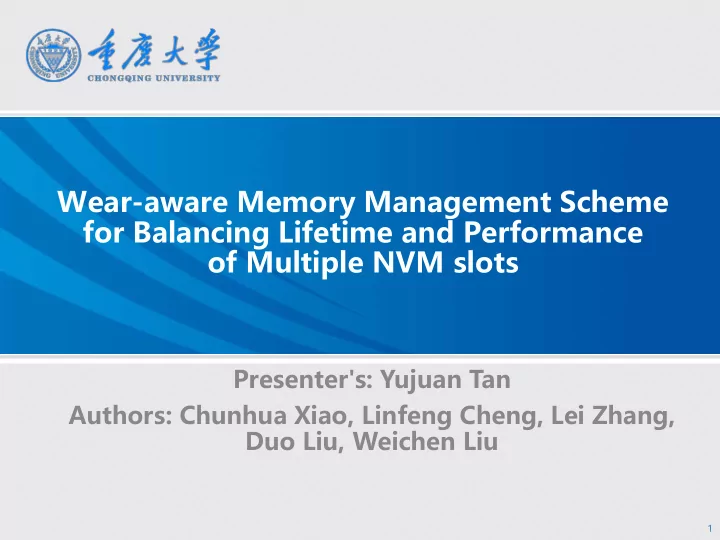

Wear-aware Memory Management Scheme for Balancing Lifetime and Performance of Multiple NVM slots Presenter's: Yujuan Tan Authors: Chunhua Xiao, Linfeng Cheng, Lei Zhang, Duo Liu, Weichen Liu 1
目 录 Background Motivation Design Evaluation
Background NVM PERSISTENT 3DXPOINT BYTE-ADDRESSABILITY PCM LOW LATENCY HIGH DENSITY PRAM 3
Background Lifetime limit of NVM SSD RAM NVM HDD magnetic NAND DRAM PCM 10 9 10 12 10 6 10 15 10 18 Endurance (# of write times) CPU SSD RAM NVM HDD CACHE SRAM DRAM PCM NAND magnetic 10 0 10 1 10 2 10 3 10 4 10 5 10 6 ACCESS TIME (ns) 4
Motivation Hardware Wear-Leveling technology for NVM Software Wear-Leveling technology for NVM 5
Motivation Hardware Wear-Leveling technology for NVM Single NVM Software Wear-Leveling technology for NVM 6
Motivation Extend the lifetime Hardware Wear-Leveling for multiple NVMs technology for NVM Memory Management Single NVM Innovation for In-Memory File System Point Collaborate with Software Wear-Leveling Hardware Wear-Leveling technology for NVM for single NVM 7
Design OVERVIEW Wear-Counter • Recording the number of writes of each NVM • Dynamic aware the wear of each NVM and be used to adjust the use of each NVM Allocation Strategy • Considering concurrent workload pattern • Enhancing lifetime and minimizes the cost of performance 8
Design Wear Counter • Record the total number of writes of each NVM. • Insert auditing code in the file write path • Write-Through (WT) strategy. • Write-Back (WB) Strategy. 9
Design Allocation strategy • Per-CPU Free List Lease Use First • Counters-Group • FreeLists-Group • Lease Use First Out strategy. 10
Design Counters-Group • m Counters-Group • n global persistent NVM-Counter • n local CPU-NVM-Counter • Least use first strategy on each Counters-Group • From local wear-leveling to global wear-leveling 11
Design FreeLists-Group • m FreeLists-Group • n local CPU-NVM-FreeList on FreeLists-Group of each CPU • Each local CPU-NVM-FreeList is organized as a single linked list 12
Evaluation Configuration 参 数 项 具体配置 OS Ubuntu 16.04 Kernel Linux 4.4.4 CPU Intel i5-6500, 4-Core, 3.20 GHz 16GB DDR3 2133MHz DRAM DRAM NVM 8GB DRAM to emulate 4 NVMs 13
Evaluation Lifetime • Outperform wear-leveling effect by more than 2600x • The lifetime can be prolonged by 2.5x 14
Evaluation Performance • PMFS-WASA-WB basically shows the best performance in high concurrent workload. • PMFS-WASA-WT has the worst performance. • The performance is improved up to 15% when 16 threads and 64KB block size. 15
16
Recommend
More recommend